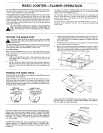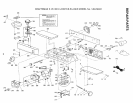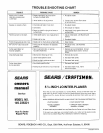
WARNING: NEVER PLACE THE HEEL OF YOUR HAND AT
_ THE END OF THE WORK PIECE WHEN FINISHING A CUT.
THIS COULD RESULT IN YOUR HAND COMING IN CONTACT
WITH THE CUTTER CAUSING SERIOUS INJURY,
At the end of the cut, position your hand on TOP NEAR THE END
of the work piece and continue feeding the work piece until the
cutter guard has returned to its closed position,
RIGHT
/
USING HOLD DOWN/PUSH BLOCKS
ALWAYS use the hold downlpush blocks when JOINTING wood
that is NARROWER than 3 in. or PLANING wood that is THINNER
than 3 in.
Grasp the hold down/push blocks firmly with the fingers close to-
gether and wrapped around the handle. Position them flat on top of
workpiece, and push the workpiece down against the table to pro-
vide a quality cut and minimize the chance of a kickback.
Hold down pressure must be sufficient to prevent hold down/push
block from sliding or slipping on the surface of the workpiece when
advancing work piece over cutter head.
Use a hand-over-hand motion of the hold downlpush blocks being
careful to maintain control of the workpiece at all times.
HAND'OVER HAND
This means that once the work piece has passed the cutter head
onto outfeed table, one hold down/push block must always main-
tain contact with the work piece with outfeed table.
When planing wood 3/4 in. thick and NARROWER than the hold
downlpush block, tilt the hold down/push block so that it clears
the top of the cutter guard while feeding.
Never plane wood that is thinner than 112 in...because it is apt to
split or shatter and thus has a greater tendency to kickback.
,_ CAUTION: IF THE HOLD DOWN/PUSH BLOCKS TEND TO
SLIP WHILE FEEDING, CLEAN RUBBER SURFACE IMMEDI-
ATELY WITH SANDPAPER.
BEVELING AND CHAMFERING
The fence on your jointer-planer is adjustable from 45 ° inboard to
45 ° outboard. Adjust the fence to desired angle and tighten lock
knobs.
BEVELING is the cutting of an angle on the entire edge of a board.
Beveling may require several passes due to the depth of cut needed
to bevel entire edge of board.
BEVEL
EDGE
x
CHAMFER
EDGE
INBOARD 4(_, .-."_ /
llJ' )
11
CHAMFERING is removing only the corner of the edge of a board.
Normally a chamfer is made with one cut therefore, a cut deeper
than 1116" may be made.


















